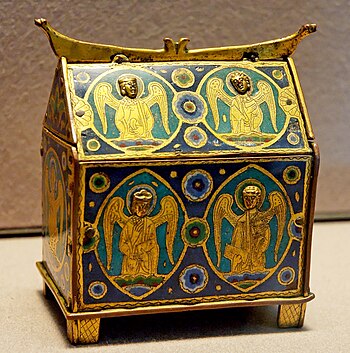When I first thought about doing this article I considered all of the very detailed information that has been written about enameling, and then I thought sometimes people want to just have a basic understanding of a process, without too many details. So basic it is.
Enameling is a process of decorating the surface of metal with color. The earliest examples of enamel work appear to have been done in Egypt about 1600 BC, so the process has been around for a very long time.

Box with angels, intended to contain small bottles of holy oils. Champlevé enamel over gilt copper, early 13th century, Limoges (Limousin, France). (Photo credit: Wikipedia)
Unfortunately, in modern times the word enamel has come to refer to a type of paint. But we are not talking about paint, we are talking about melted glass. We are also not talking about “cold enamel”, which is actually colored epoxy.
Enameling is usually done only on fairly high carat gold or fine silver objects, but it can be done on true bronze and copper. Why the limitations on the types of metal? Because the process of heating the metal to adhere the enamel causes the metal to share molecules with the enamel in the form of metal salts. Metal salts are what are used to actually color glass, so additional metals salts will change the color of the glass.
The basic enameling process goes like this. Glass is ground up and then rinsed in clean water to remove any cloudiness. The powdered glass is then placed in contact with an appropriate metal. It can be held in place by indentations in the metal, or wires. It can also have organic glue, which will burn off during the heating process, mixed with it to help hold the powdered glass in place.
The actual process of heating up the metal and glass is called “firing”, the same as with pottery. The metal and powered glass are heated until the glass fuses back together into a sheet on the surface of the metal. The glass is now enamel.
You may wonder what makes the glass stick to the metal. Molten glass generally likes sticking to metal, as any lamp worker who has ever had a bead get stuck on a tool or mandrel can tell you. This natural tendency can also be improved by carved out depressions in the metal for the enamel to melt into, and these depressions can be made even more efficient by creating an “undercut” on the sides of them. This undercut creates a physical lock on the sides of the enamel that helps to hold it in place.
The care and feeding of enamel. Enamel is, after all, glass. If you bend the metal on which it is placed it will very likely crack and it may even pop off. Smacking a piece of enamel on a hard, sharp object will almost certainly chip the enamel, the same way your windshield is chipped by a flying stone. The fact that we have thousands of pieces of jewelry, and decorative pieces that still have enamel on them, after hundreds, and sometimes thousands of years, is a testament to the fact that enamel is a wearable and functional form of decoration.
I hope that this brief article has given you some insight into the basic concept of glass enamel.
- picture of enamel (Photo credit: Wikipedia)


